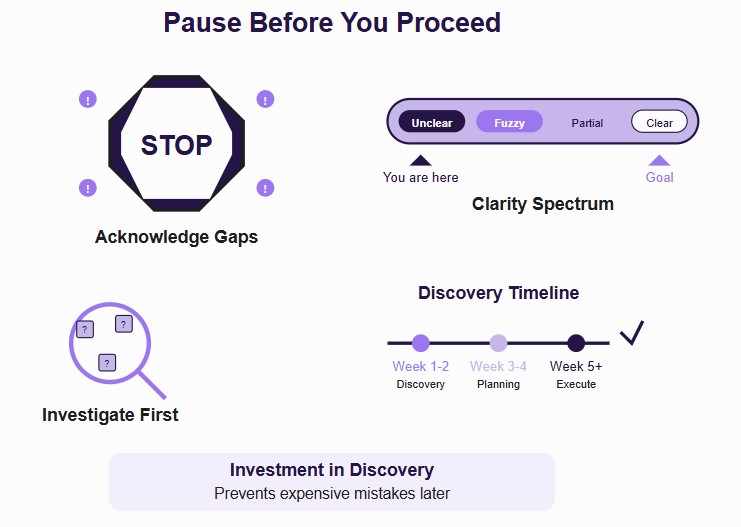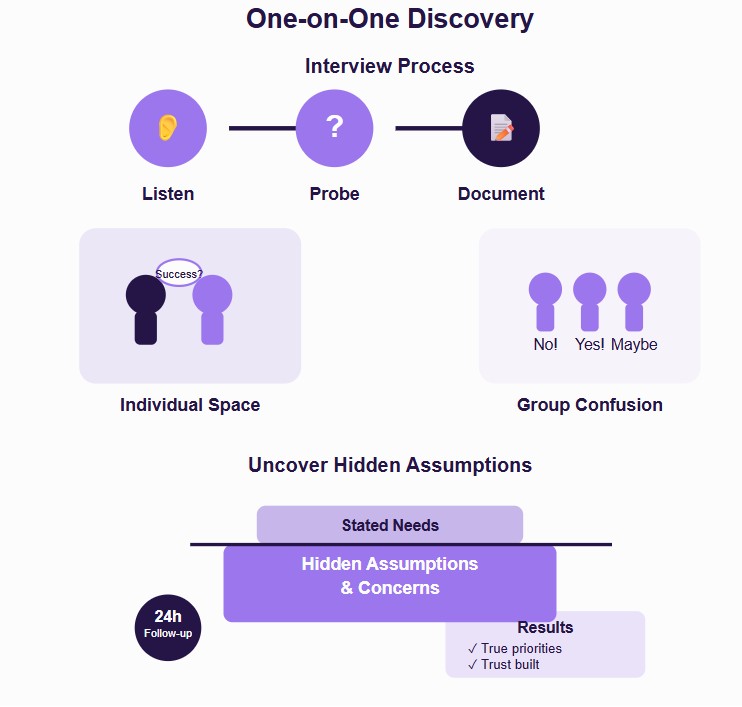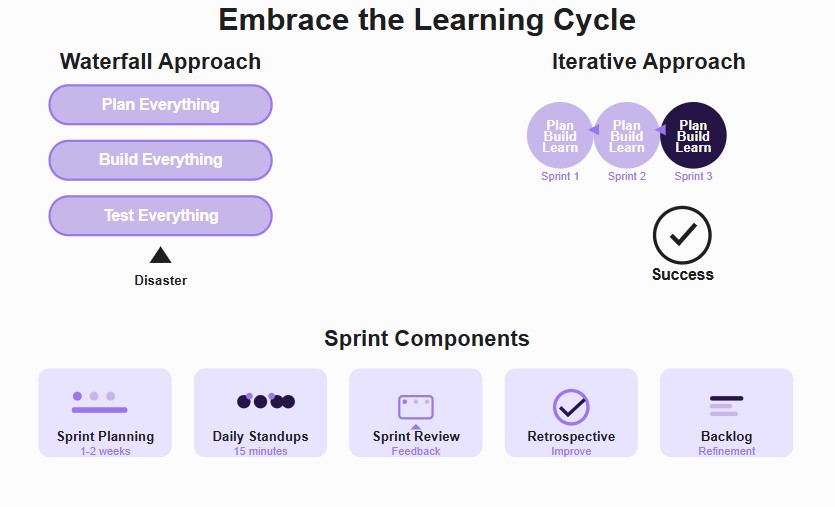A staggering 37% of project failures are caused by poor requirement gathering, according to PMI. Yet, most teams don’t realize the problem until it’s too late.
How managers can handle unclear project requirements often determines whether a project stays on track or unravels fast. Spotting the early signals and addressing ambiguity head-on can save months of rework and frustration.
In this article, we will explore:
- Transform messy requirements into a clear project roadmap
- Identify unclear requirements before they derail your project
- Learn how smart leadership can rescue failing projects fast
Turn project chaos into clarity: A manager's 6-step blueprint for tackling unclear requirements
When project requirements feel like scattered puzzle pieces, many managers make the fatal mistake of rushing forward, hoping clarity will emerge along the way. This approach almost always leads to scope creep, budget overruns, and frustrated stakeholders.
The reality is that unclear requirements are not roadblocks; they're opportunities to build stronger, more successful projects through systematic clarification. Here's your proven roadmap to turn confusion into crystal-clear direction:
Step 1: Acknowledge ambiguity and avoid rushing to execution
The first step to solving unclear requirements is admitting they exist. Many project managers fall into the pressure trap from executives and proceed with projects based on their own assumptions, but acknowledging uncertainty upfront prevents costly mistakes down the road.
Key Actions:
- Resist the urge to fill gaps with assumptions
- Communicate transparently with stakeholders about what's unclear
- Set realistic timelines that account for discovery time
- Document initial concerns and areas needing clarification
- Gain leadership buy-in for the requirement clarification process
Pro Tip: Frame ambiguity as "discovery opportunity" rather than "project delay" when communicating with executives. This positions you as proactive rather than problematic.

Step 2: Use clarification frameworks (5 Whys, MosCow, user stories)
Structured frameworks transform vague ideas into actionable requirements. Rather than hoping for clarity through endless meetings, systematic approaches like the 5 Whys technique dig deeper into the real problem, while MoSCoW prioritization separates must-haves from nice-to-haves.
Essential Frameworks:
- 5 Whys Technique: Drill down to root causes and true business needs
- MoSCoW Method: Must have, Should have, Could have, Won't have prioritization
- User Stories: "As a [user], I want [goal] so that [benefit]" format
- SMART Criteria: Specific, Measurable, Achievable, Relevant, Time-bound requirements
- Acceptance Criteria: Clear definition of "done" for each requirement
Pro Tip: Combine frameworks for maximum impact - start with 5 Whys to understand the problem, then use user stories to define solutions, and MoSCoW to prioritize them.
Step 3: Conduct stakeholder interviews to unpack assumptions
Every stakeholder carries hidden assumptions about what the project should deliver. One-on-one interviews create a safe space for honest dialogue where stakeholders feel comfortable sharing concerns, expectations, and unstated needs that group meetings often miss.
Interview Best Practices:
- Ask open-ended questions like "What does success look like to you?"
- Listen for emotional language that reveals true priorities
- Probe assumptions with "Help me understand why..." questions
- Document exact quotes to preserve stakeholder intent
- Follow up within 24 hours to confirm understanding
Pro Tip: Interview stakeholders separately first, then bring them together. Individual conversations reveal conflicts and concerns that surface later as "scope creep."

Step 4: Document knowns and unknowns early
Creating a clear inventory of what you know versus what you don't know prevents teams from operating on different assumptions. This transparency builds trust with stakeholders and provides a roadmap for filling knowledge gaps systematically.
Documentation Strategy:
- Known Requirements: Clearly defined and validated needs
- Unknown Requirements: Areas requiring further investigation
- Assumed Requirements: Educated guesses that need validation
- Conflicting Requirements: Stakeholder disagreements to resolve
- Risk Requirements: Potential future needs based on likely scenarios
Pro Tip: Use a simple three-column format (Know, Don't Know, Assume) and share it with all stakeholders. This visual approach makes gaps obvious and actionable.
Step 5: Validate assumptions through small experiments or prototypes
Don't let assumptions remain theoretical; test them quickly and cheaply. Small experiments, mockups, or prototypes reveal flawed thinking early when changes are still inexpensive, rather than after development when fixes cost exponentially more.
Validation Techniques:
- Paper prototypes: Quick sketches to test user interface concepts
- Proof of concepts: Small technical experiments to validate feasibility
- User testing sessions: Watch real users interact with early concepts
- A/B testing: Compare different approaches with actual data
- Stakeholder walkthroughs: Present concepts and gather immediate feedback
Pro Tip: Set a "fail fast" mentality, aim to invalidate bad assumptions within one week, not one month. Speed of learning beats perfection of planning.
Step 6: Set up iterative planning (Agile > Waterfall in these cases)
When requirements are unclear, traditional waterfall planning becomes a recipe for disaster. Agile approaches embrace uncertainty as natural and create structured ways to refine understanding through short cycles of planning, building, and learning.
Agile Implementation:
- Sprint planning: Short 1-2 week cycles for rapid learning
- Daily standups: Quick alignment on discoveries and blockers
- Sprint reviews: Regular stakeholder feedback on actual deliverables
- Retrospectives: Team learning sessions to improve the process
- Backlog refinement: Continuous requirement prioritization and clarification
Pro Tip: Even if your organization isn't "Agile," you can apply iterative principles by breaking unclear requirements into smaller investigation tasks with regular check-ins.

Unclear requirements aren't project killers; they're simply unfinished work. When you apply these six strategic steps consistently, you'll not only deliver better outcomes but also build stronger stakeholder relationships along the way.
Catch it before it crashes: Why requirements go unclear (and how to spot the red flags early)
Unclear requirements don’t just happen; they creep in silently and snowball into missed deadlines, scope creep, and stakeholder frustration. But when you understand what causes the fog and how to detect it early, you can take action before your project veers off course.
Here’s what’s really behind unclear requirements and how to spot the warning signs before they cost you.
What causes requirements to be so vague in the first place
Unclear requirements aren’t always the result of poor communication—they’re often rooted in structural and organizational issues. Here are the top culprits:
- Skipping the discovery phase: Jumping into solutioning before understanding the actual problem
- Too many decision-makers: When everyone owns the outcome, no one owns the clarity
- Lack of a product owner or requirement owner: No single person accountable for requirement accuracy
- Unspoken assumptions: Stakeholders think they’re on the same page, but never explicitly align
- Rapid timelines or executive pressure: Leads to “just build it” mentality without asking critical questions
Pro Tip: Before blaming “bad requirements,” check if the process to gather them even existed.
Early symptoms that you’re headed for trouble
These signs often show up early - but managers ignore them, hoping things will clear up later. They rarely do.
Be on high alert if you notice:
- Vague, high-level language like “make it better” or “user-friendly.”
- Frequent changes or pivots in direction shortly after kickoff
- Multiple interpretations of the same requirement across teams
- No shared definition of ‘done’ between stakeholders and delivery teams
- Developers and designers are asking more clarification questions than usual
- Stakeholders nodding in meetings but giving conflicting feedback later
Pro Tip: Treat the first wave of confusion as a signal, not an inconvenience. That’s your cue to dig deeper.
Diagnostic checklist: Are you working with unclear requirements
Ask yourself (and your team) these questions. If you answer "no" or "not sure" to many of them, you're likely operating in ambiguity.
- Do we have a clearly defined business goal, ideally documented in a project charter, driving this project?
- Has someone been officially assigned to own the requirements?
- Can we explain what success looks like in measurable terms?
- Have user needs or use cases been validated and documented?
- Is there a clear definition of done that everyone agrees on?
- Do stakeholders agree on priorities and non-negotiables?
- Have we mapped out what we don’t know yet and how we’ll validate it?
Pro Tip: Use this checklist as a kickoff ritual. Revisit it anytime requirements start to feel unstable or contradictory.
By learning to spot unclear requirements early, you gain precious time to correct course, engage stakeholders with better questions, and protect your team from wasting effort.
From chaos to clarity: How one IT manager turned project disasters into success stories
Real-world proof that the right approach works. This verified PMI case study shows exactly how Hospital El Pilar's IT Manager faced the same challenges you're dealing with and won.

The crisis: Multiple "urgent" projects going nowhere
Hospital El Pilar in Guatemala City had a critical problem: their IT team was completely stalled despite having multiple urgent healthcare projects. Adolfo Enrique Galán Paz, the IT Manager, watched project after project fail to deliver patient care systems, billing solutions, and mobile apps that the hospital desperately needed.
Where clarity was missing
The team faced the classic requirement nightmare trifecta:
- Unclear priorities: "Every project was defined as urgent, which ultimately left the team unsure of how to focus its efforts."
- Zero visibility: "We had little visibility into the progress of projects and requirements, which led us to try to cover a lot and, in the end, there was no progress at all."
- Minimal stakeholder interaction: "We only had interaction with users at the beginning and end of projects. That caused us not to deliver what the client required."
Sound familiar? The team was building in isolation, constantly switching priorities, with no clear definition of success.
The manager's strategic response
Instead of pushing forward with unclear requirements, Galán completely restructured their approach using the six-step framework:
Steps 1-2: Acknowledged the problem and implemented systematic frameworks
- Openly admitted their approach wasn't working
- Adopted user story prioritization with clear acceptance criteria
- Created proper documentation where none existed before
Steps 3-4: Revolutionized stakeholder engagement and documentation
- Included stakeholders directly in the development team
- Built a monitoring dashboard showing real progress and bottlenecks
- Established continuous collaboration instead of isolated interactions
Steps 5-6: Validated assumptions and embraced iterative planning
- Moved to short iteration cycles with regular demonstrations
- Implemented daily coordination meetings and sprint planning
- Created feedback loops for continuous requirement refinement
The measurable results
The transformation delivered concrete outcomes:
- Multiple high-profile projects completed successfully, including patient tracking systems and billing solutions
- We have managed to deliver better solutions in a more professional manner with fewer errors.
- More projects are finished on time.
- Rebuilt stakeholder trust through transparency and regular involvement
This isn't just a nice success story - it's proof that unclear requirements are solvable problems. As the PMI coach who guided their transformation noted: "You can start at the moment exactly where you are... and still create an immediate impact."
Turn unclear inputs into confident deliverables
Unclear project requirements aren’t a dead end; they’re a signal to lead with intention. By slowing down, applying the right frameworks, engaging stakeholders early, and validating assumptions through small iterations, managers can replace confusion with clarity.
You don’t need perfect inputs to deliver great outcomes, just a process that turns ambiguity into structure. Use the six-step approach, and you won’t just manage projects; you’ll guide them with confidence.



_light%201.png)





